Quito Tourism offers a unique blend of historical charm, cultural richness, and natural beauty. Are you planning a trip to Quito and wondering what the best attractions are? SIXT.VN is here to guide you through this vibrant city with its stunning colonial architecture, breathtaking Andean landscapes, and a wealth of cultural experiences. Discover Quito’s top attractions, hidden gems, and essential travel tips to make your visit unforgettable. For convenient and reliable travel solutions, consider SIXT.VN for airport transfers, comfortable hotel bookings, and expertly guided tours, ensuring a seamless exploration of Ecuador’s capital. Explore historical sites, scenic views, and cultural immersion.
1. Exploring Quito’s Historical Center: A UNESCO World Heritage Site
Is Quito’s historical center worth visiting? Absolutely! Quito’s historical center, a UNESCO World Heritage Site, is a must-see for any visitor. This area boasts the largest and best-preserved historic center in South America, offering a captivating journey through 300 years of Spanish colonization.
- Architectural Splendor: The colonial architecture, with its intricate sculptures and frescoes, is beautifully maintained, showcasing the city’s dedication to preserving its heritage.
- Cultural Immersion: Getting lost in the narrow, colorful streets allows you to soak in the vibrant atmosphere and discover hidden gems.
1.1 Plaza Grande and Palacio de Carondelet
What is the significance of Plaza Grande? Plaza Grande (Independence Square) is a central landmark, surrounded by colonial-style buildings and the Palacio de Carondelet, the presidential palace.
- Changing of the Guard: The changing of the guard ceremony takes place at 11 a.m. on Mondays, a spectacle worth witnessing.
- Free Tour: You can take a free tour of the presidential palace, which lasts about an hour. Make sure to reserve your place in advance and bring your passport or a copy.
- Alberto Mena Caamaño Museum: Located next to the palace entrance, this museum offers a fascinating glimpse into Quito’s history.
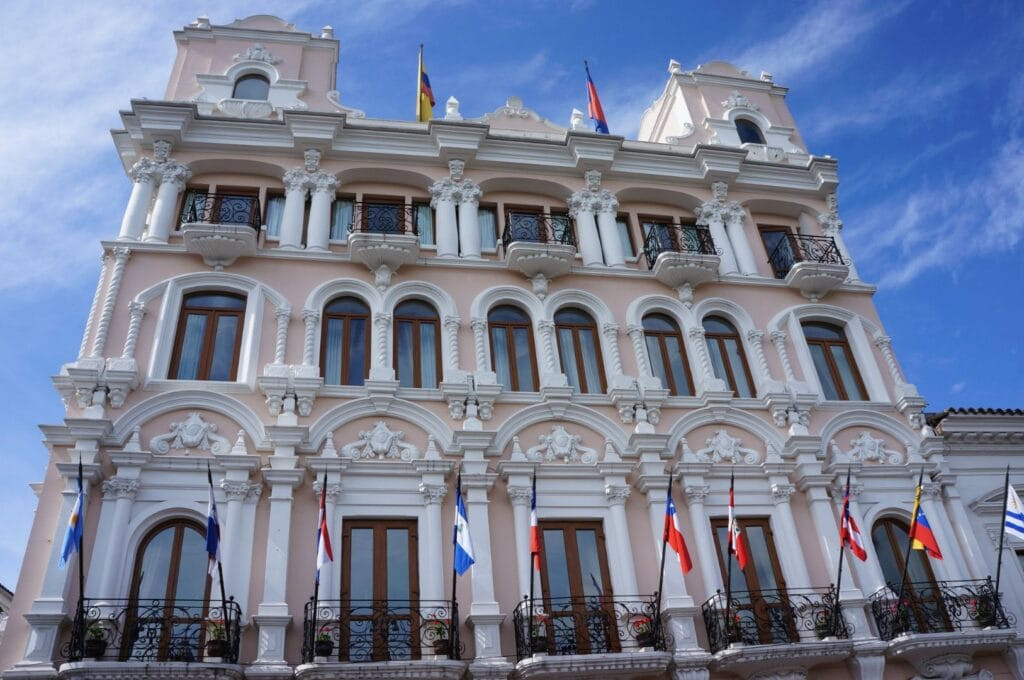 Plaza Grande in Quito, Ecuador, featuring colonial-style buildings and the Presidential Palace, capturing the historical essence of Quito tourism
Plaza Grande in Quito, Ecuador, featuring colonial-style buildings and the Presidential Palace, capturing the historical essence of Quito tourism
1.2 Plaza de San Francisco
Why visit Plaza de San Francisco? Plaza de San Francisco is home to the Church and Convent of San Francisco, one of the largest religious complexes in South America.
- Architectural Styles: Built in the late 16th century, the church showcases a blend of different architectural styles.
- Historical Significance: As the oldest church in Quito, it holds immense historical importance.
- La Bodega de Cantuña: Enjoy a drink at La Bodega de Cantuña, a restaurant/bar with a lovely terrace overlooking the square.
According to UNESCO, The Plaza de San Francisco is the most visited place in Quito with nearly 500,000 tourist visits annually.
 San Francisco Church and Convent in Quito, Ecuador, displaying its unique architectural styles and historical significance for Quito tourism
San Francisco Church and Convent in Quito, Ecuador, displaying its unique architectural styles and historical significance for Quito tourism
1.3 Calle de la Ronda
What makes Calle de la Ronda unique? Calle de la Ronda is one of Quito’s oldest streets, known for its charming, colorful houses and unique architecture.
- Traditional Beverage: Don’t miss trying canelazo, a traditional alcoholic beverage made from sugarcane alcohol, cinnamon, and sugar, served hot.
- Atmosphere: Visit in the late afternoon to enjoy the cozy bars and charming atmosphere.
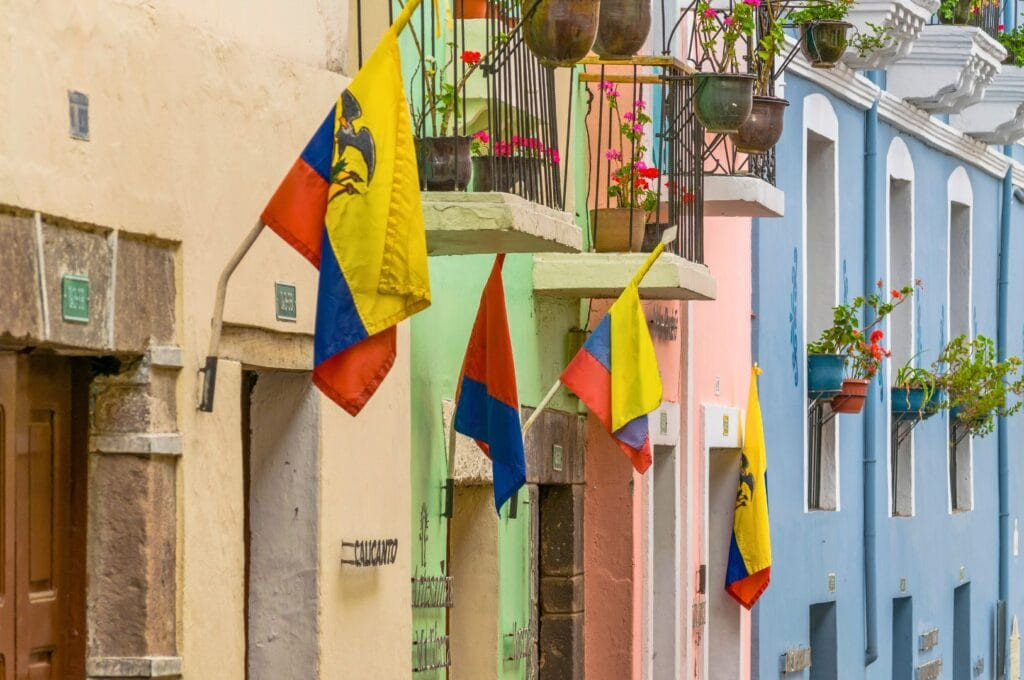 Colorful facades of houses in Calle de la Ronda, Quito, Ecuador, showcasing the unique architecture and vibrant atmosphere for Quito tourism
Colorful facades of houses in Calle de la Ronda, Quito, Ecuador, showcasing the unique architecture and vibrant atmosphere for Quito tourism
1.4 Basilica del Voto Nacional
What is special about Basilica del Voto Nacional? The Basilica del Voto Nacional is an architectural marvel with its impressive Gothic style and towers that offer panoramic views of Quito.
- Ecuadorian Gargoyles: The facades feature gargoyles representing Ecuadorian animals like iguanas, turtles, and toucans.
- Climbing the Towers: Climb the towers for breathtaking views of Quito and the Panecillo. You can even go inside the clock!
- Café at the Top: Enjoy coffee and cake with a view at the café located at the top of one of the towers.
 Basilica del Voto Nacional, Quito, Ecuador, featuring its impressive Gothic style and towers, a must-see for Quito tourism
Basilica del Voto Nacional, Quito, Ecuador, featuring its impressive Gothic style and towers, a must-see for Quito tourism
1.5 Free Walking Tours
How can a free walking tour enhance my Quito experience? Free walking tours are an excellent way to discover Quito’s historical center with a local guide.
- Local Insights: These tours provide valuable insights into the city’s history and culture.
- Tipping: If you enjoy the tour, you can tip the guide as you see fit.
2. El Panecillo: Quito’s Iconic Hill
What is El Panecillo, and why should I visit? El Panecillo, meaning “little bread,” is a hill in the middle of Quito, topped with a 41-meter-high aluminum statue of the Virgin (Virgen del Panecillo).
- Symbol of the City: The Virgin is a symbol of Quito and is visible from anywhere in the city.
- Breathtaking Views: The view from El Panecillo is stunning on a clear day.
- Climbing Inside the Virgin: For $1, you can climb inside the Virgin for a 360° view of Quito.
2.1 Getting to El Panecillo Safely
How can I get to El Panecillo safely? While it’s possible to walk up to El Panecillo, it’s safer to take a driver, cab, or public bus due to reports of theft. A round trip cab ride costs about $8.
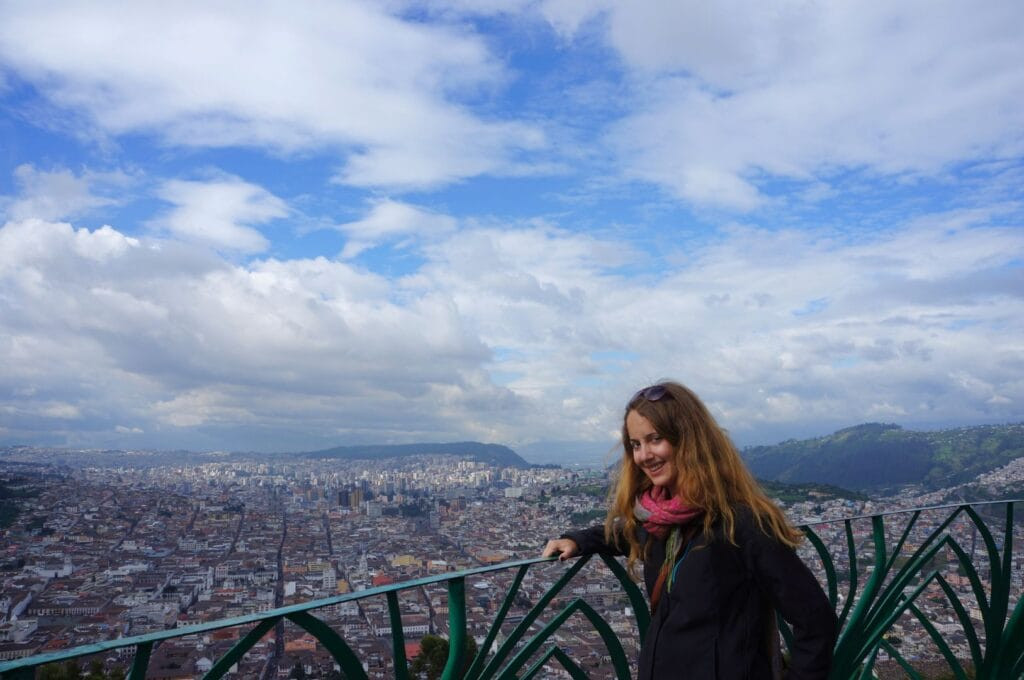 View of Quito from the Virgen del Panecillo, Ecuador, offering breathtaking panoramic views and highlighting the city's landscape for Quito tourism
View of Quito from the Virgen del Panecillo, Ecuador, offering breathtaking panoramic views and highlighting the city's landscape for Quito tourism
3. Exploring Quito’s Parks: A Breath of Fresh Air
Are there green spaces in Quito to relax and explore? Yes, Quito has several parks that offer a refreshing escape from the urban environment.
3.1 Parque Metropolitano Guangüiltagua
What makes Parque Metropolitano Guangüiltagua special? Parque Metropolitano is Quito’s largest park, offering forests, paths, and stunning views.
- Size: The park is twice the size of New York’s Central Park.
- Activities: Perfect for jogging, barbecues, and enjoying nature.
- Llamas: The park is home to an adorable herd of llamas.
- Volcano Views: Enjoy views of the Cotopaxi and Cayambe volcanoes.
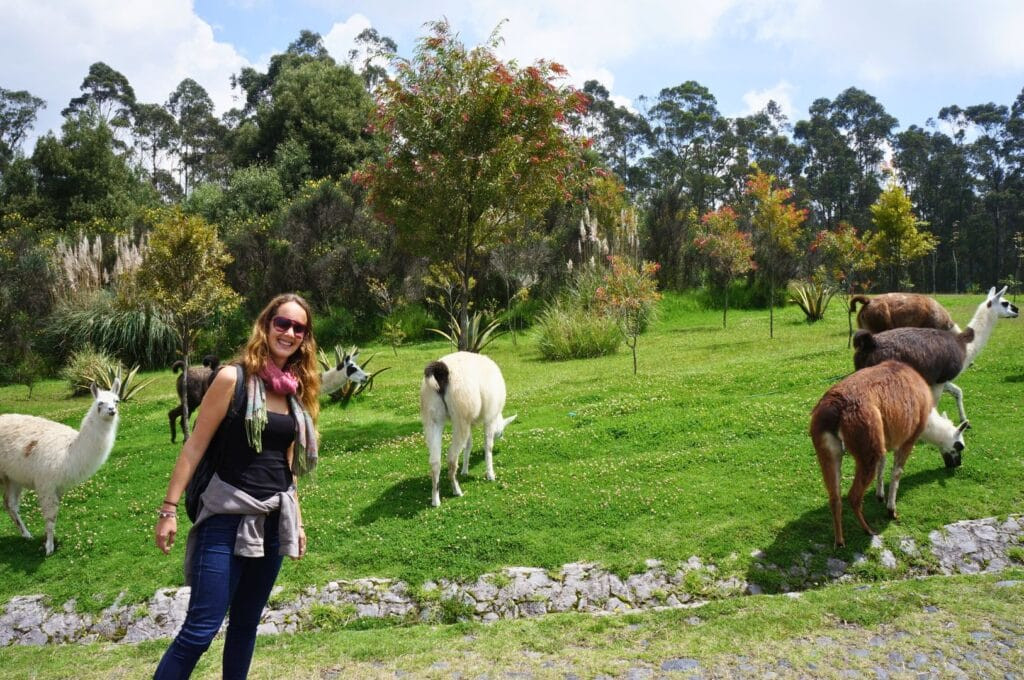 Llamas in Parque Metropolitano, Quito, Ecuador, showcasing the park's natural beauty and recreational opportunities for Quito tourism
Llamas in Parque Metropolitano, Quito, Ecuador, showcasing the park's natural beauty and recreational opportunities for Quito tourism
3.2 Parque La Carolina
What can I do at Parque La Carolina? Parque La Carolina is located in the heart of downtown Quito and offers a variety of recreational activities.
- Activities: Play football, basketball, or Ecuavolley (a variation of volleyball popular in Ecuador).
- Food and Drinks: Enjoy fresh fruit juice and snacks from street vendors.
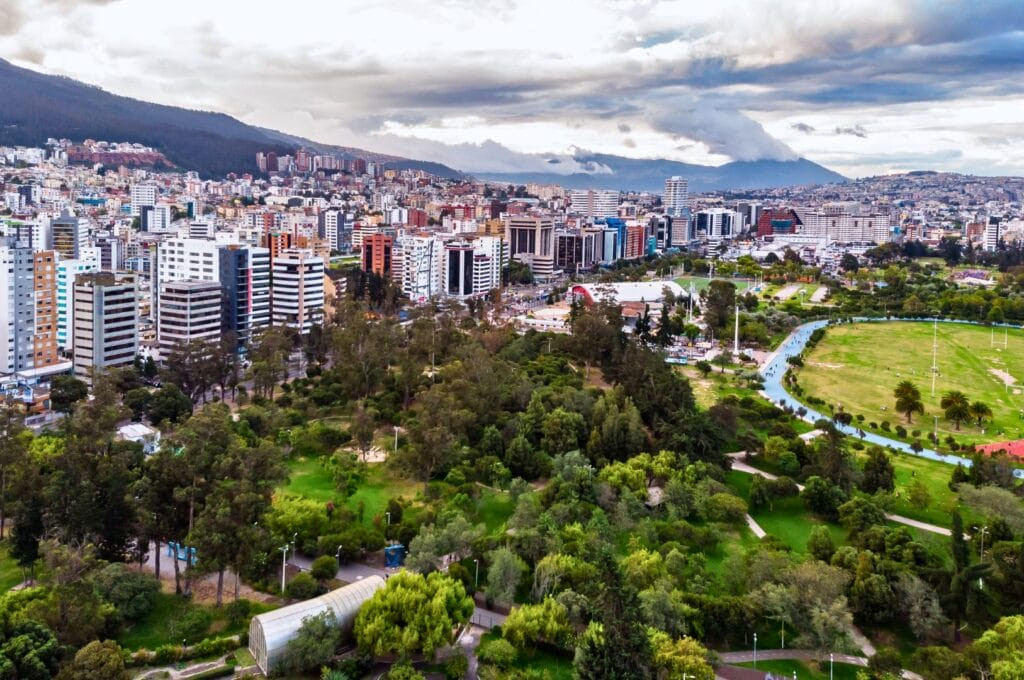 La Carolina Park in Quito, Ecuador, showcasing its recreational activities and central location for Quito tourism
La Carolina Park in Quito, Ecuador, showcasing its recreational activities and central location for Quito tourism
3.3 Quito Botanical Garden
Why should I visit the Quito Botanical Garden? The Quito Botanical Garden is a pleasant surprise, featuring reproductions of typical Ecuadorian environments.
- Diverse Ecosystems: Explore the coast, the Andes, and the Amazon ecosystems.
- Greenhouses: Discover magnificent orchids and carnivorous plants in the greenhouses.
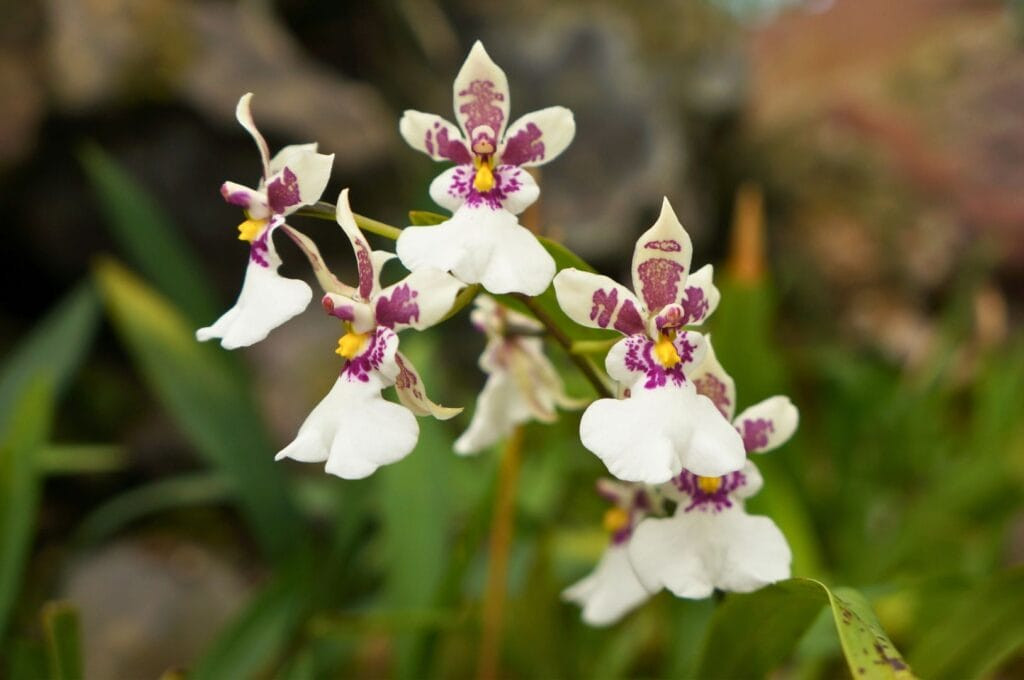 Orchids in the Quito Botanical Garden, Ecuador, highlighting the garden's diverse plant life and natural beauty for Quito tourism
Orchids in the Quito Botanical Garden, Ecuador, highlighting the garden's diverse plant life and natural beauty for Quito tourism
3.4 Other Parks in Quito
What other parks are worth visiting in Quito? Other parks worth visiting include Parque Bicentenario, located on the site of the old airport, and El Ejido Park, famous for its painters.
4. El TeleferiQo: Ascending the Pichincha Volcano
What is El TeleferiQo, and what does it offer? El TeleferiQo is a cable car that climbs up the slope of the Pichincha volcano to an altitude of 4,000 meters, offering incredible panoramic views.
- Stunning Views: Enjoy a stunning view of Quito and, on a clear day, the Cotopaxi, Antisana, and Cayambe volcanoes.
- Safety: It’s best to take a taxi to the cable car, as the area can be a bit dodgy.
- Operating Hours: The cable car is open from 10 a.m. to 7 p.m. Monday to Thursday and from 8 a.m. to 7 p.m. Friday to Sunday. Tickets cost $9 per person round trip.
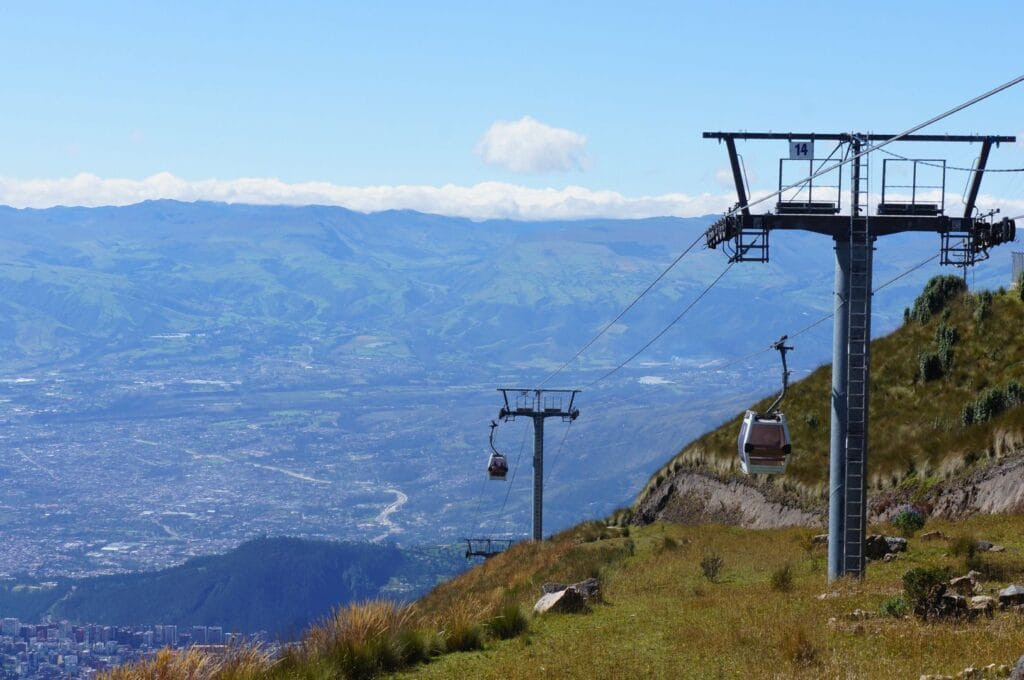 El TeleferiQo in Quito, Ecuador, ascending the Pichincha volcano and offering breathtaking views of the city for Quito tourism
El TeleferiQo in Quito, Ecuador, ascending the Pichincha volcano and offering breathtaking views of the city for Quito tourism
4.1 Hiking to the Summit of Rucu Pichincha
How challenging is the hike to Rucu Pichincha? If you’re in good physical condition, you can hike from the top of the cable car to the summit of Rucu Pichincha at 4696 meters.
- Duration: Allow between 4 and 7 hours round trip.
- Difficulty: The last part is quite challenging, involving a climb rather than a hike.
- Worth the Effort: The panorama from the top is absolutely incredible.
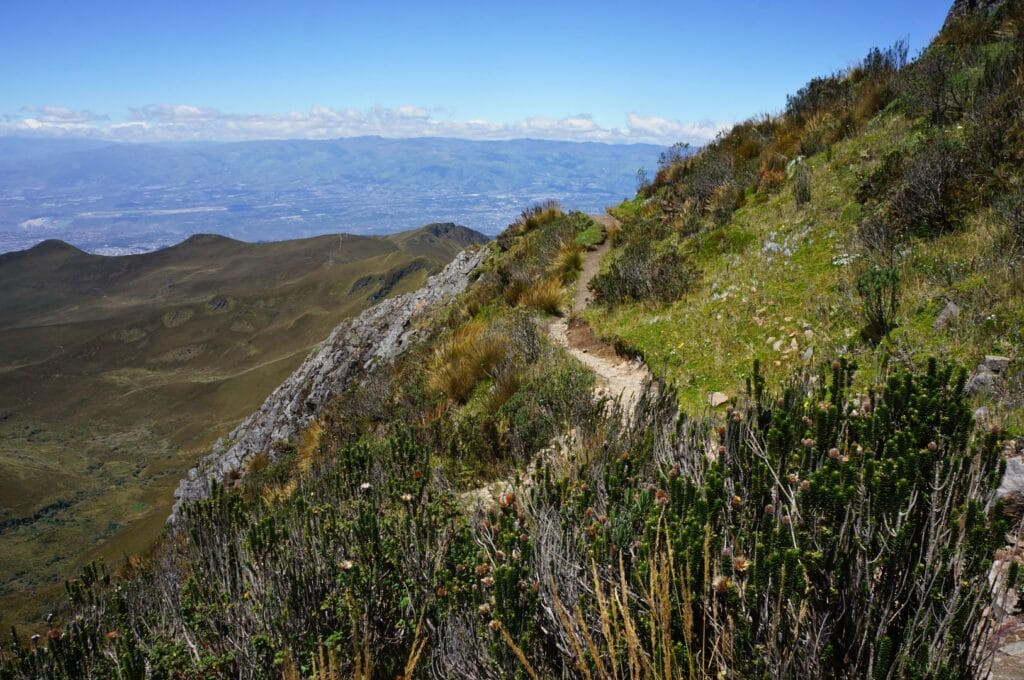 Hiking trail on the Pichincha volcano in Quito, Ecuador, leading to the summit and offering challenging yet rewarding experience for Quito tourism
Hiking trail on the Pichincha volcano in Quito, Ecuador, leading to the summit and offering challenging yet rewarding experience for Quito tourism
5. Shopping in Quito: From Malls to Markets
Where can I find the best shopping experiences in Quito? Quito offers a variety of shopping options, from modern malls to traditional markets.
5.1 Quicentro
What can I find at Quicentro? Quicentro is Quito’s biggest and fanciest shopping mall, offering local and international brands. Prices are relatively high due to taxes on imported items.
5.2 Quito’s Markets
Where can I find affordable clothes and souvenirs in Quito? For cheap clothes, shoes, and other items, visit the San Roque market near the Panecillo.
- Otavalo Market: If you have more time, take a day trip to the Otavalo market, 2 hours from Quito, for a huge selection at very good prices.
- Mercado Central and Mercado Iñaquito: Visit the central market (Mercado Central) for a wide variety of fruits, vegetables, and traditional cuisine. The Mercado Iñaquito offers fresh, local food at excellent value.
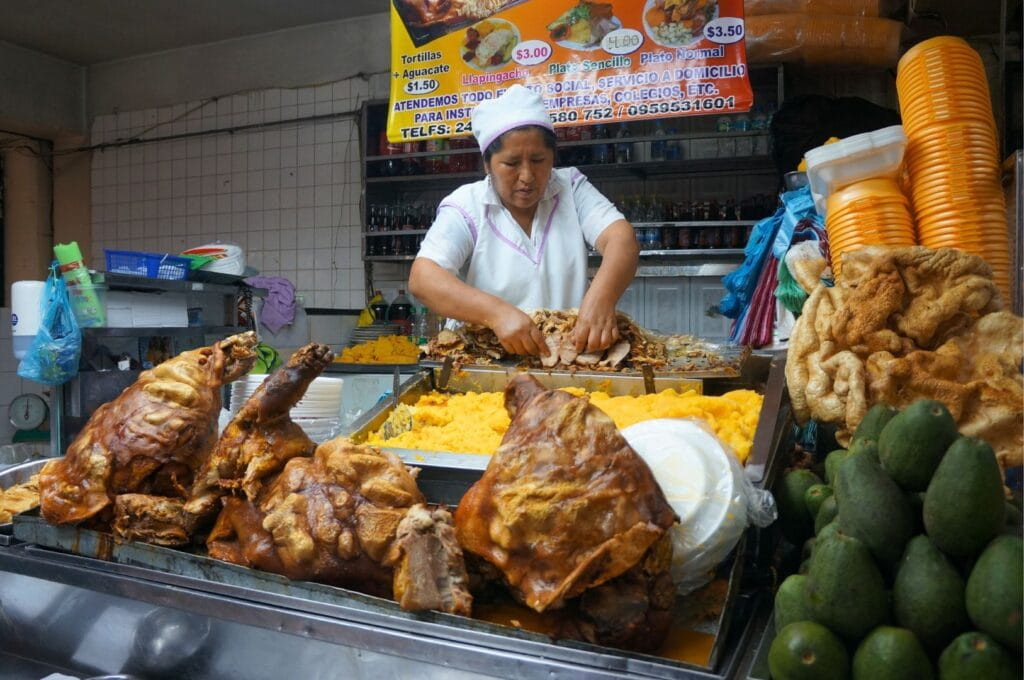 Stall in a Quito market, Ecuador, showcasing the variety of local products and offering a vibrant shopping experience for Quito tourism
Stall in a Quito market, Ecuador, showcasing the variety of local products and offering a vibrant shopping experience for Quito tourism
6. Learning Spanish in Quito: Immerse Yourself in the Culture
Why is Quito an excellent place to learn Spanish? Quito is an excellent place to learn Spanish due to its charming city and the clear, slow Spanish spoken by its inhabitants.
- Spanish Schools: There are many Spanish schools in Quito offering intensive classes.
- Cultural Immersion: Learning Spanish enhances your travel experience and allows you to communicate with locals.
According to the Instituto Cervantes, Ecuador is the most desirable location to learn Spanish due to its safety and neutral accent.
7. Day Trips from Quito: Exploring Ecuador’s Diversity
What are some must-see destinations near Quito? Ecuador is a small country with many possibilities for short trips from Quito.
7.1 La Mitad del Mundo
What is La Mitad del Mundo, and what can I see there? La Mitad del Mundo (the middle of the world) is located 35 km north of Quito and marks the Equator.
- Memorial and Museum: Visit the large memorial and the Templo del Sol museum, which tells the story of the scientists’ task to measure the Earth.
- Sitio Intiñan Museum: The monument is not located exactly on the Equator, but the Sitio Intiñan museum is.
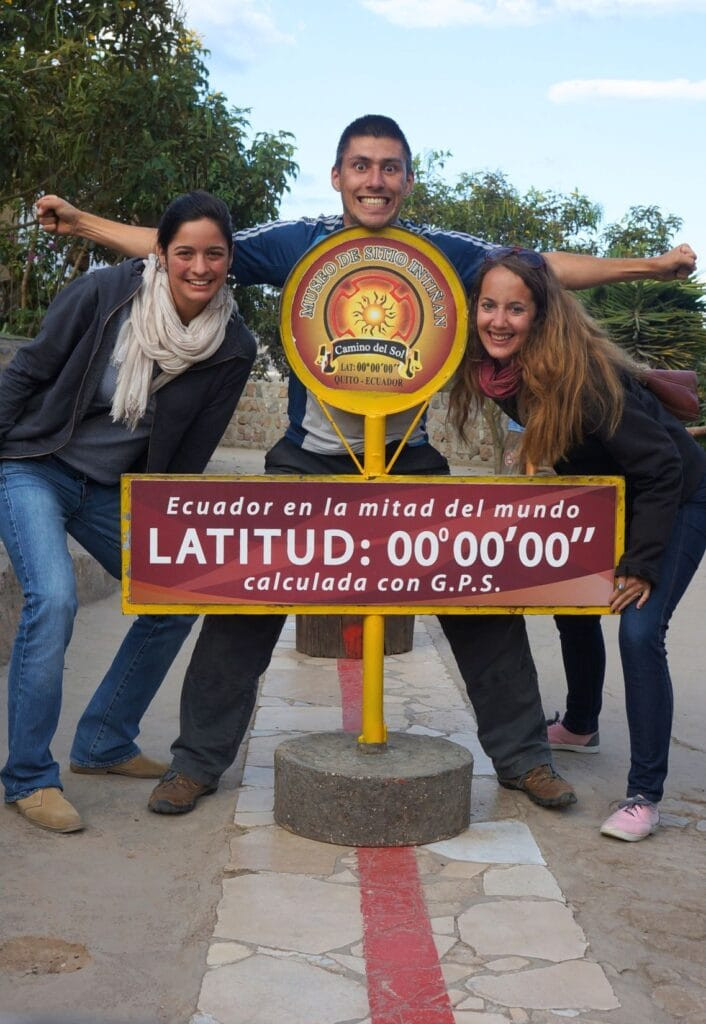 In the middle of the world at the Mitad del Mundo monument in Quito, Ecuador, experiencing the Equator and learning about its scientific significance for Quito tourism
In the middle of the world at the Mitad del Mundo monument in Quito, Ecuador, experiencing the Equator and learning about its scientific significance for Quito tourism
7.2 Otavalo Market
Why visit Otavalo Market? The Otavalo market is renowned for the quality of its textiles and handicrafts.
- Shopping: Find a huge choice of items at very good prices.
- Transportation: Take a bus from the Carcelén bus station in Quito for around $3 for a 2-hour journey.
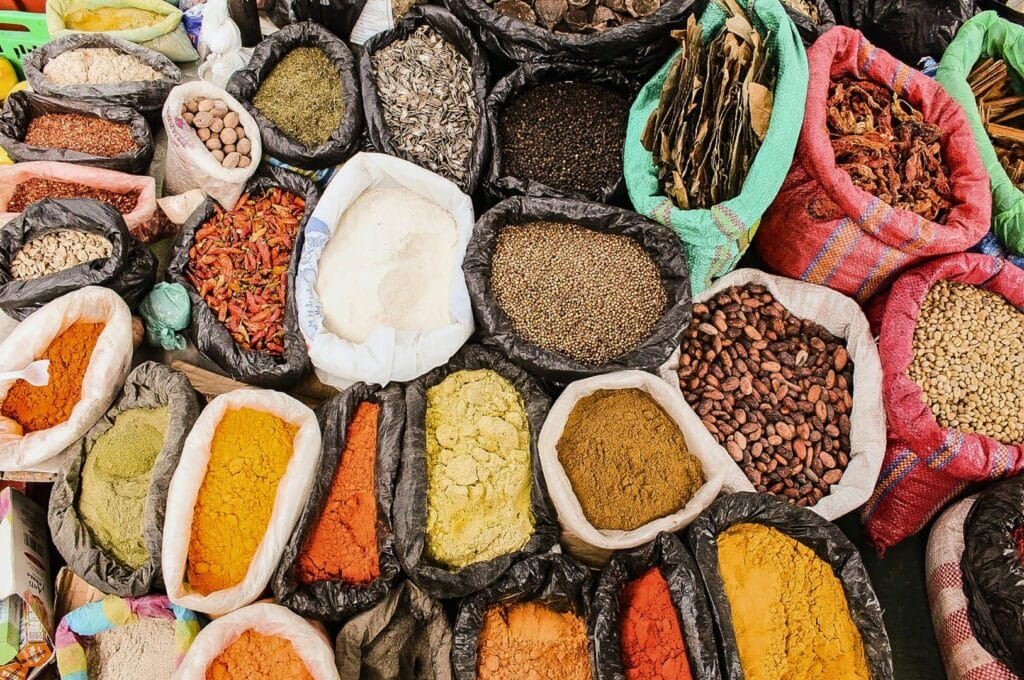 Spices at the Otavalo market, Ecuador, offering a sensory experience and highlighting the local culture and commerce for Quito tourism
Spices at the Otavalo market, Ecuador, offering a sensory experience and highlighting the local culture and commerce for Quito tourism
7.3 Laguna de Cuicocha
What is unique about Laguna de Cuicocha? Laguna de Cuicocha is a lake inside a crater at the foot of the Cotacachi volcano.
- Scenery: Enjoy the sublime scenery with the imposing volcano in the background.
- Boat Trip: Take a short boat trip on the lagoon for $3.
- Hiking: A 5-hour walk around the lake and crater offers stunning views.
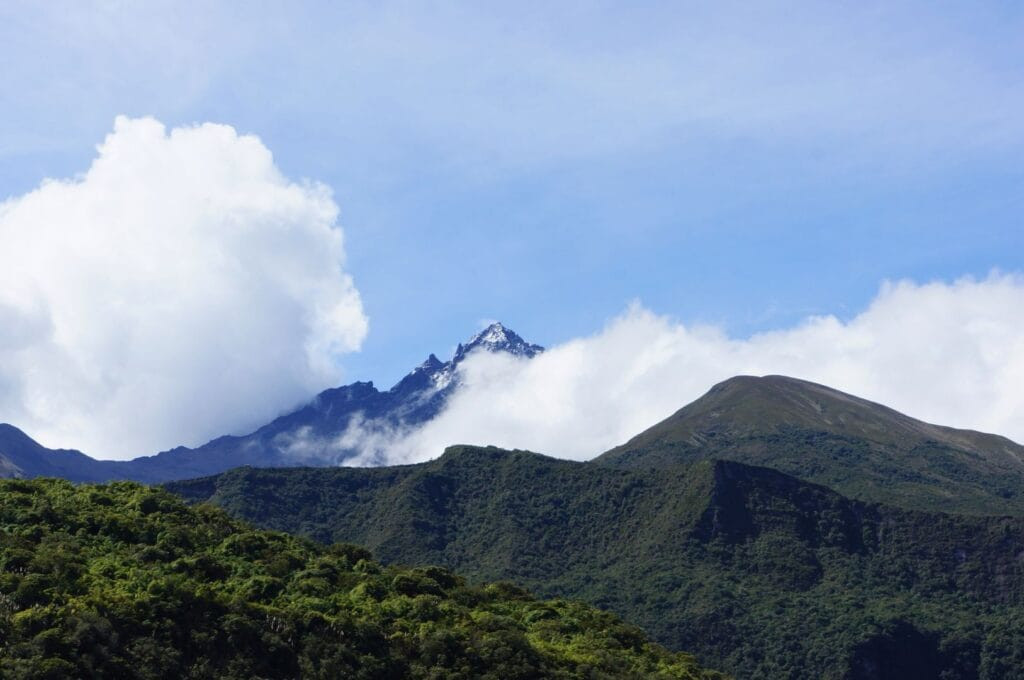 The Cotacachi volcano seen from Laguna de Cuicocha in Ecuador, showcasing the stunning natural landscapes and hiking opportunities for Quito tourism
The Cotacachi volcano seen from Laguna de Cuicocha in Ecuador, showcasing the stunning natural landscapes and hiking opportunities for Quito tourism
7.4 Mount Fuya Fuya and Mojanda Lakes
What can I experience at Mount Fuya Fuya and Mojanda Lakes? Climb to the summit of Mount Fuya Fuya (4279 m) to discover the beautiful landscape surrounding the Mojanda lagoon.
- Challenging Hike: The hike is steep but rewarding.
7.5 Laguna de Quilotoa
What makes Laguna de Quilotoa special? Laguna de Quilotoa is another lake in a crater, offering the possibility of trekking from village to village for several days.
- Trekking: The scenery is well worth the effort.
 Laguna de Quilotoa in Ecuador, showcasing the stunning crater lake and the surrounding landscapes perfect for trekking and Quito tourism
Laguna de Quilotoa in Ecuador, showcasing the stunning crater lake and the surrounding landscapes perfect for trekking and Quito tourism
7.6 Baños
What activities are available in Baños? Baños is considered the extreme sports capital of Ecuador, offering waterfalls, hot springs, rafting, mountain biking, and more.
7.7 Cotopaxi
Why visit Cotopaxi? Cotopaxi is a perfectly shaped volcano with a snow-capped peak, one of Ecuador’s symbols.
- Day Trips: Take a day trip to the refuge or go mountain biking.
- Climbing: If you want to reach the summit, you’ll need 2 days and a guide.
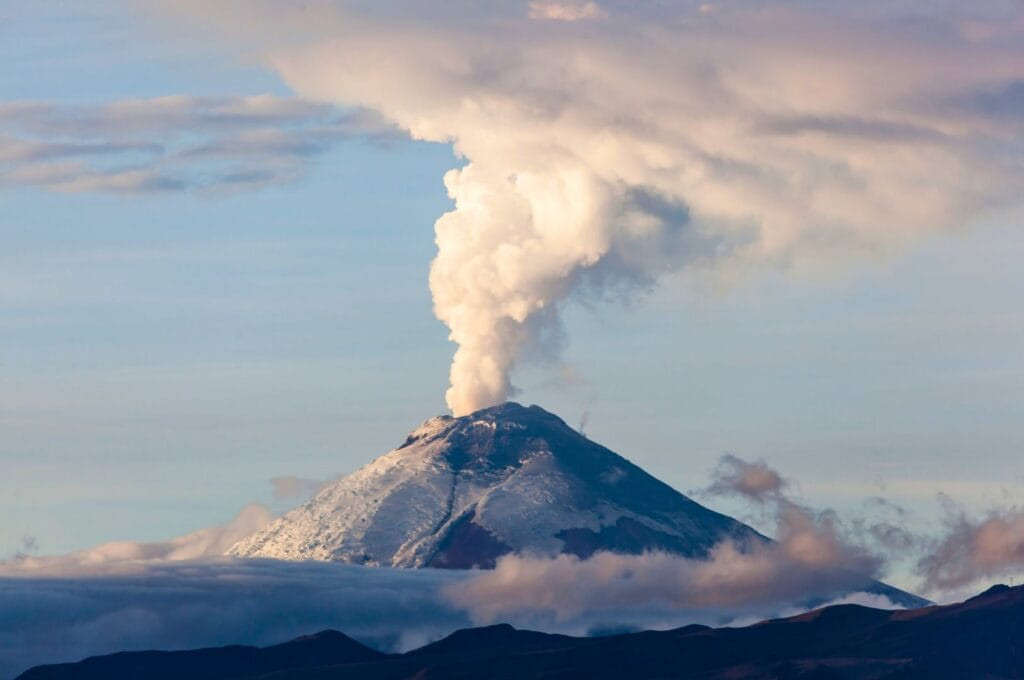 Cotopaxi volcano from Quito, Ecuador, displaying its perfectly shaped snow-capped peak and offering opportunities for hiking and climbing for Quito tourism
Cotopaxi volcano from Quito, Ecuador, displaying its perfectly shaped snow-capped peak and offering opportunities for hiking and climbing for Quito tourism
7.8 Mindo
What is Mindo known for? Mindo is located in the rainforest and is known for its incredible diversity of birds and insects.
- Activities: Enjoy rafting, zip-lining, and mountain biking.
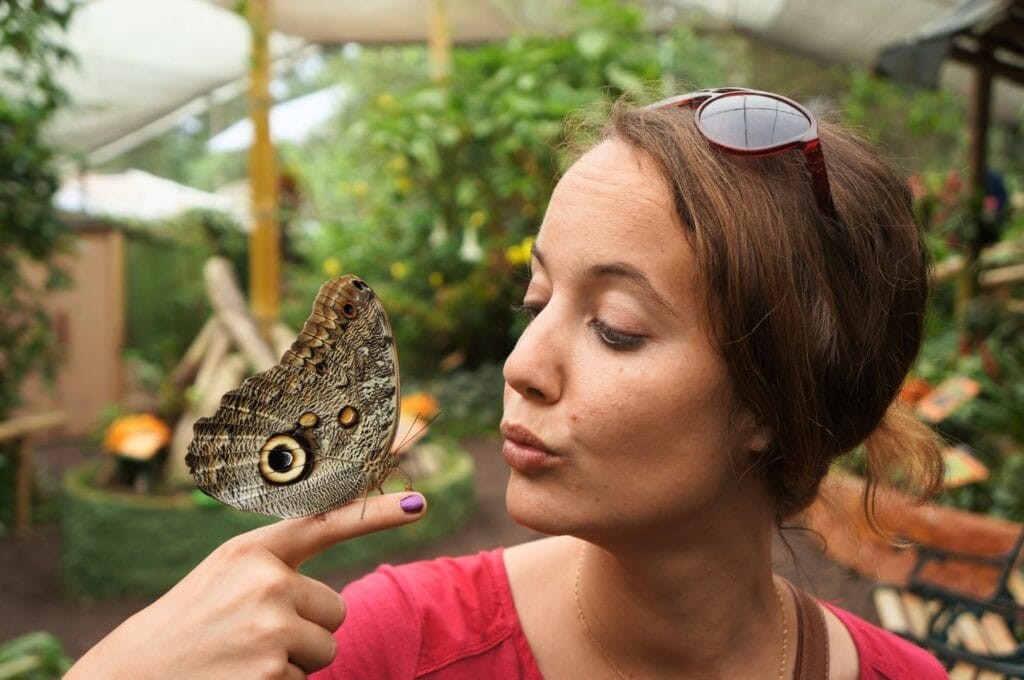 Fabienne with a butterfly in Mindo, Ecuador, showcasing the region's biodiversity and attracting nature enthusiasts for Quito tourism
Fabienne with a butterfly in Mindo, Ecuador, showcasing the region's biodiversity and attracting nature enthusiasts for Quito tourism
7.9 Other Things to Do Around Quito
What other attractions are near Quito? Other attractions include the Papallacta hot springs and the Yanacocha Biological Reserve.
Papallacta Hot Springs
Relax in the hot springs and enjoy the surrounding nature and views of the Antisana volcano.
Yanacocha Biological Reserve
Discover the rainforest and its multicolored fauna.
8. Food in Quito: A Culinary Journey
What are some must-try dishes in Quito? Gastronomy may not be Quito’s strongest point, but there are still some dishes to try.
- Almuerzo: The typical midday meal consists of chicken or fish soup, rice with potatoes and meat, and a glass of fruit juice.
- Tortillas de Guaranda: Thick pancakes topped with cheese.
- Fruits: Explore the markets for delicious fruits like árbol tomato (tamarillo), pomegranate, and taxo.
- Chocolate: Try the delicious hot chocolates available in many places.
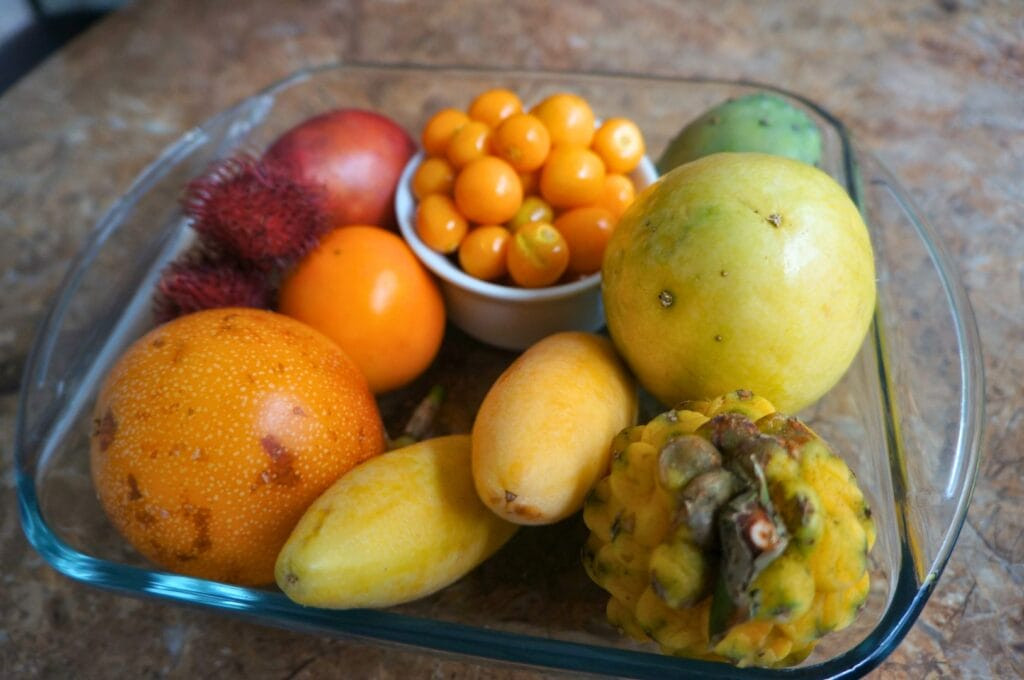 Fruits in Ecuador, showcasing the delicious and unique varieties available in Quito's markets for Quito tourism
Fruits in Ecuador, showcasing the delicious and unique varieties available in Quito's markets for Quito tourism
9. Accommodation in Quito: Where to Stay
Where are the best areas to stay in Quito? Choose accommodation in or near the historic center or towards La Mariscal for a safe and convenient experience.
- Backpackers: Latinos Brothers House is a great option for budget travelers.
- Budget Double Room: Colonial House Inn and Hostal Juana de Arco offer basic but comfortable rooms with breakfast.
- Apartments: Rent an entire apartment through Booking for a home-like experience.
10. Getting Around Quito: Transportation Options
How can I navigate Quito efficiently? The best ways to get around Quito are by bus and metro, which cross the city from north to south.
10.1 From Mariscal Sucre International Airport
What is the best way to get from the airport to Quito? Take the bus or airport shuttle bus for an inexpensive way to get to the heart of Quito.
- Bus: Take line 198 to the Rio Coca terminal and then a cab to the historic center.
- Airport Shuttle Bus: The ticket costs $8 per person and goes directly to Bicentennial Park.
10.2 In the City
How do I use public transportation in Quito? The whole city is served by bus. There are 3 main lines: the green line (el trole), the blue line (metrobus), and the red line (ecovia). A bus ticket costs just $0.25.
- Metro: The metro runs longitudinally between El Labrador station in the north and the Quitumbe bus terminal in the south.
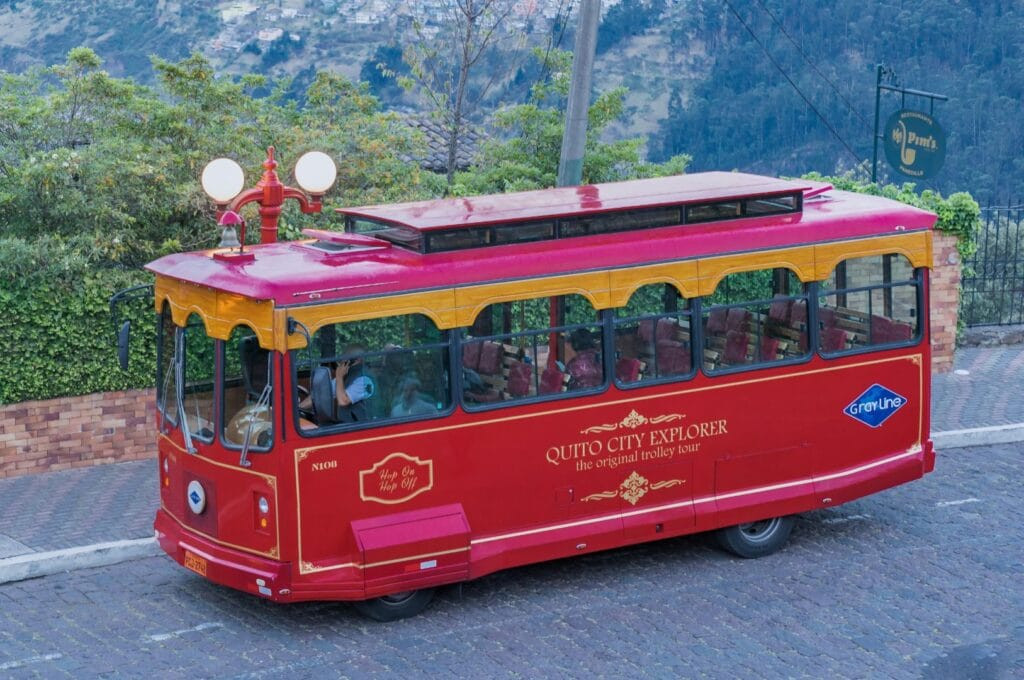 Trolley in the streets of Quito, Ecuador, representing the city's public transportation system and making it accessible for Quito tourism
Trolley in the streets of Quito, Ecuador, representing the city's public transportation system and making it accessible for Quito tourism
10.3 Taxi
When should I use a taxi in Quito? During the day, taxis operate on a taximeter. From 7-8 p.m., most cabs stop using the meter, so you’ll have to negotiate the price.
- Uber and Cabify: Hire the services of a driver via Uber or Cabify for a cheaper option.
10.4 Outside the City
How can I travel to destinations outside Quito? The best way to get out of Quito and travel around the region is by bus.
- Quitumbe Terminal: Located in the south for destinations on the coast, in the Amazon, and the Andes.
- Carcelén Terminal: Located to the north for the Otavalo market.
11. Quito’s Climate: Best Time to Visit
When is the best time to visit Quito? The best time to visit Quito is between June and September, during the dry season.
- Temperatures: Temperatures fluctuate between 10 and 20°C year-round.
- Rainy Season: The wet season is between October and May.
 Sunset over Quito, Ecuador, capturing the city's skyline and the beauty of the Andean landscapes for Quito tourism
Sunset over Quito, Ecuador, capturing the city's skyline and the beauty of the Andean landscapes for Quito tourism
12. Safety in Quito: Staying Vigilant
Is Quito a safe city for tourists? Quito is not a safe city, and it’s essential to take precautions.
12.1 Safety Rules in Quito
What safety measures should I take in Quito?
- Neutral Clothing: Wear as neutral clothing as possible and avoid showing off wealth.
- Taxis After Dark: After 7 p.m., always take cabs.
- Local Recommendations: Follow the recommendations of locals who know the dangerous neighborhoods.
- Carry Cash and a Copy of Your Passport: Avoid taking your credit card and original passport.
- Relax: A cheerful, smiling person generally attracts less attention than a stressed or suspicious person.
*According to the Overseas Security Advisory Council (OSAC), tourists should avoid walking alone at night and always use reputable transportation services.
FAQ About Quito Tourism
Q1: Is Quito worth visiting?
Yes, Quito is definitely worth visiting. It boasts the largest and best-preserved historic center in South America, a UNESCO World Heritage Site, and offers a unique blend of historical charm, cultural richness, and natural beauty.
Q2: What is the best time of year to visit Quito?
The best time to visit Quito is between June and September, during the dry season, when the weather is more predictable and sunny.
Q3: Is Quito a safe city for tourists?
Quito is not considered a very safe city, and it’s essential to take precautions such as avoiding walking alone at night, using reputable transportation services, and not displaying valuable items.
Q4: What are the must-see attractions in Quito’s historical center?
Must-see attractions include Plaza Grande, Palacio de Carondelet, Plaza de San Francisco, Calle de la Ronda, and the Basilica del Voto Nacional.
Q5: How can I get around Quito?
The best ways to get around Quito are by bus and metro, which cross the city from north to south. Taxis, Uber, and Cabify are also available.
Q6: What is El Panecillo, and why should I visit it?
El Panecillo is a hill in the middle of Quito, topped with a 41-meter-high statue of the Virgin, offering breathtaking views of the city.
Q7: What are some popular day trips from Quito?
Popular day trips from Quito include La Mitad del Mundo, Otavalo Market, Laguna de Cuicocha, Baños, and Cotopaxi National Park.
Q8: What kind of food should I try in Quito?
You should try the almuerzo (typical midday meal), tortillas de Guaranda, and the delicious fruits available in the markets.
Q9: Is it easy to learn Spanish in Quito?
Yes, Quito is an excellent place to learn Spanish due to its clear, slow-spoken Spanish and numerous language schools.
Q10: What should I pack for a trip to Quito?
Pack layers of clothing, as the weather can change quickly. Also, bring sunscreen, a hat, and comfortable shoes for walking.
SIXT.VN is your trusted partner for exploring Quito, offering reliable airport transfers, comfortable hotel bookings, and expertly guided tours to ensure a seamless travel experience. Contact us today to start planning your adventure! Address: 260 Cau Giay, Hanoi, Vietnam. Hotline/Whatsapp: +84 986 244 358. Website: SIXT.VN. Let SIXT.VN help you discover the best of Quito with ease and comfort.



